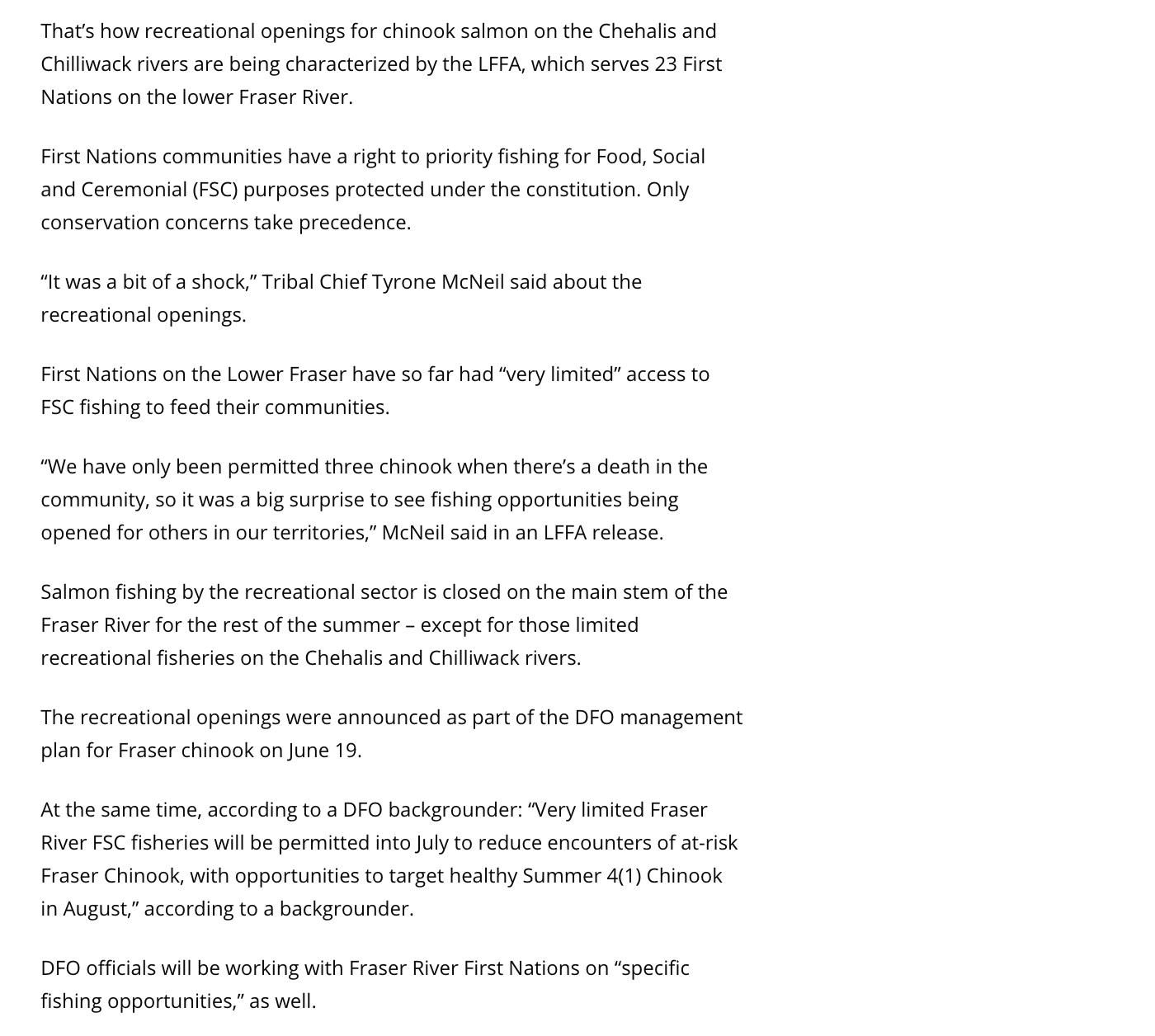
3 minute read
Fisheries Management Update
Fisheries Management Update: Summer 2020
Aidan Fisher, Staff Biologist
Advertisement
Chinook
Fraser chinook have entered the Fraser, with peak migration of spring run chinook happening over the next few weeks. Spring run Chinook are assessed in-season at the Albion test fishery. To date catch at Albion has been very low, 55 chinook caught since April 21. In comparison, 199 chinook had been caught by July 29 in 2019. The goal of the Albion test fishery is to make standardized fishing sets, two drifts daily, which can be used to infer relative run size of Fraser chinook stocks. Low catch at Albion is indicative of a low return for spring run chinook. It is apparent that the spring run chinook return in 2020 is again extremely low.
Management measures for Fraser chinook by DFO to date have been criticized numerous times. DFO had been continuing to use management measures from 2019 in 2020, despite a technical review that identifies impact by marine recreational fisheries much higher than planned.
Throughout spring 2020, catch-and-release marine recreational fisheries have remained open, while communal FSC chinook fisheries have been closed. The only access licenced for Lower Fraser First Nations FSC fisheries has been through request for ceremonial fisheries, 33 chinook have been harvested in 2020 to date.
On June 19, 2020, DFO announced a new suite of chinook fishery management measures for FSC, recreational and commercial chinook fisheries. DFO has once again not taken decisive action in marine recreational fisheries. They have added a new area of “no fishing for chinook”, but have it is different from chinook non-retention nor described how it is enforceable. They are implementing extensions to slot limit fisheries in the marine approach recreational fisheries, while maintaining substantial restrictions to FSC fisheries.
Slot limit fisheries mean any chinook caught over 80cm must be released. Catch and release fisheries induce mortality by the fishing interaction and can be exacerbate by poor handling practices. The impact to a released chinook can manifest in multiple ways through direct mortality from the event, reduced fitness resulting in predation by seals or sea lions or compromising its ability to migrate to the spawning grounds.
Release mortality or fishery related induced mortality is still an area where there is a substantial amount of uncertainty on the true impact. Whenever a new study adds another factor to consider on induced mortality for Fraser salmon the impact from the fishing event increases.
DFO has also announced chinook recreational fisheries in a number of Lower Fraser tributaries where hatchery enhancement occurs. These fisheries are open either currently or in the next few weeks for chinook.
The latest announcement by DFO clearly shows they are unwilling to take the necessary management action against the marine recreational fishery to prioritize chinook escapement to the spawning grounds or FSC priority access.
For potential FSC fisheries in the summer, they will be heavily scrutinized by DFO regarding projected impact to Upper Fraser chinook stocks. DFO has communicated that they will be continuing with the same restrictions as 2019 in 2020 for FSC fisheries. Expect another year of heavily restricted chinook fisheries.
Sockeye
The Fraser Panel has finalized preseason discussion of the Fraser sockeye fishery and are moving into in-season management.
The Fraser sockeye forecast midpoint is at 941,000. This is the lowest Fraser sockeye forecast since they started forecasting. At the midpoint forecast, there is no fishable surplus for any FSC, recreational or commercial fisheries. Fraser sockeye will likely be managed using the Low Abundance Exploitation Rate (LAER), which allows for some impact on Fraser sockeye from fisheries directed on co-migrating stocks (chinook fisheries).
Additionally, the forecasting process has now acknowledged an over-forecasting bias over the past 12 years, meaning the forecast is overly optimistic compared to the in-season return. If the forecast wasn’t biased then about 50% of the years would be above the midpoint forecast, and 50% below the midpoint. In the past 12 years, 9 years have been below the midpoint forecast.
Based on the preseason forecast, it is unlikely that there will be any sockeye directed FSC fisheries for Lower Fraser First Nations. There may be some allowance for sockeye retention in chinook directed fisheries. There may be further restrictions on sockeye retention if the in-season run size is extremely low. Sockeye retention regulations will be announced in-season and dependant on the run size.
The LFFA technical staff have been working with DFO technical staff to develop a framework to access sockeye in the tributaries (Chilliwack, Pitt and Harrison). It is still in development, but we expect it to be finalized before the Fraser sockeye return. If there is an abundant return of any of these Lower Fraser sockeye stocks, we hope that a directed fishery will be able to utilize this framework.







